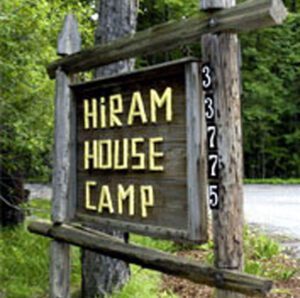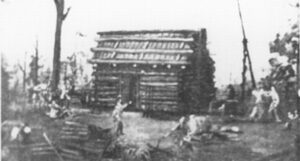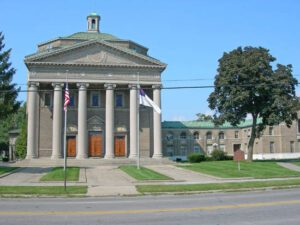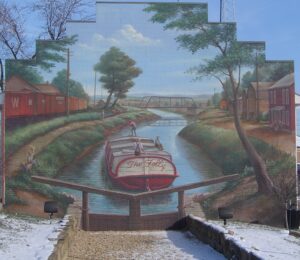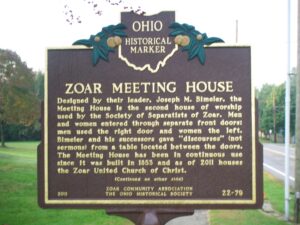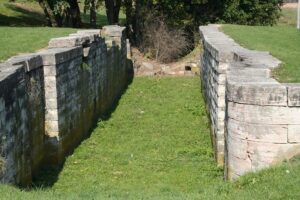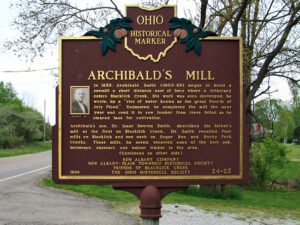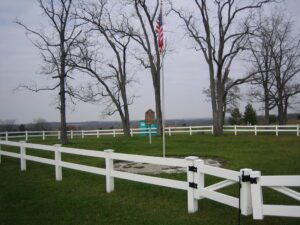, OH
Hiram House was Ohio’s first settlement house and among the earliest in the nation, opening in October 1896 in Cleveland’s Whiskey Island neighborhood. Representing the ideals of a late-1800s urban progressive movement, settlement houses provided–through “service, not charity” –health, recreational, and self-development opportunities that were not widely available in this era. Founded by Hiram College divinity graduate George A. Bellamy (1872-1960), Hiram House administered a wide range of social services for people of different ethnic and economic backgrounds. Bellamy established the “Fresh Air Camp” circa 1900; Cleveland industrialist Samuel Mather donated this tract of land in 1903. In continuous operation since its founding, Hiram House has provided outdoor experiences and educational programs for thousands of Ohio children.
, OH
In the late 1790s General Benjamin Whiteman built near this site one of the first log cabins in Alpha, the first settlement in what would become Beavercreek Township of Greene County. The cabin, later owned by Whiteman’s father-in-law, Owen Davis, and leased for use as a tavern to Peter Borders, became the first courthouse of Greene County. Twenty-five feet square, it had one room below and a chamber above, serving as the family sleeping quarters. A small ladder through a hole in the ceiling reached the upper level. The building was constructed of burr oak logs with a roof made of clapboards held in place by long poles laid across them. Considered to be one of the finest houses in that part of the county, the cabin had one door, one window, and a huge fireplace with an outside chimney built of sticks, stones, and clay. (Continued on other side)
, OH
Founded in 1833, this is the oldest congregation organized within Toledo’s original boundaries. From 1844 to 1913 the church occupied a succession of three meeting houses on St. Clair Street. In 1913 First Church merged with Central Congregational Church. The pews and eight stained glass windows from the 1878 church were incorporated into this meeting house which was dedicated in 1916.
, OH
During the 1830s, the Ohio & Erie Canal was built through Newark. The Lockmaster’s House was home to the lockmaster of Lock #9. In 1852, the first railroad locomotive steamed into Newark, signaling the beginning of the end for the canal. By 1871, the Baltimore & Ohio Railroad took over the Lockmaster’s House and the encompassing land, and built the Little Red House on the corner for the stationmaster and telegraph operator. Passenger and freight stations, a freight yard, and roundhouse were constructed nearby and served as a B&O Division Point. In 1881, the Scheidler Machine Works built a factory to manufacture steam engines and sawmills. This building now houses The Works Museum. In 1890, an electric interurban railway line connected Newark’s B&O Station to the Toledo & Ohio Central station in Granville. By 1908, the old canal was filled-in. Interurban service ended in 1929 when the city purchased buses.
, OH
Designed by their leader, Joseph M. Bimeler, the Meeting House is the second house of worship used by the Society of Separatists of Zoar. Men and women entered through separate front doors: men used the right door and women the left. Bimeler and his successors gave “discourses” (not sermons) from a table located between the doors. The Meeting House has been in continuous use since it was built in 1853 and as of 2011 houses the Zoar United Church of Christ.
, OH
This section of the Miami and Erie Canal, constructed from 1833-1837, was vital to this region’s commerce and development. It allowed for farmers and businesses to get their goods to larger markets at a lower cost and faster speed than by hauling overland. Passengers could also travel across the area by canal boat. John Clark saw the location of the Lock 15, situated in Monroe Township at the junction of the Milton-Carlisle Pike (Main Street), as an opportunity and in 1840, platted the new town of Tippecanoe City (now Tipp City). Many types of commerce and trade grew up around the canal including boarding houses, saloons, a tannery, and a mill. Some of the original buildings still stand, such as a mill to the west of Lock 15, John Clark’s home at the southeast corner of Main and First streets, and the hotel at the northeast corner of Main and Second streets.
, OH
In 1833, Archibald Smith (1803-83) began to build a sawmill a short distance east of here where a tributary enters Blacklick Creek. His work was soon destroyed, he wrote, by a “rise of water known as the great Fourth of July Flood.” Undaunted, he completed the mill the next year and used it to saw lumber from trees felled as he cleared land for cultivation. Archibald’s son, Dr. Isaac Newton Smith, described his father’s mill as the first on Blacklick Creek. Dr. Smith recalled four mills on Blacklick and one each on Sugar Run and Rocky Fork Creeks. These mills, he noted, received some of the best oak, butternut, chestnut, and walnut timber in the area. (Continued on other side)
, OH
A cemetery was established on the site in 1811 and became the final resting place for many of the area’s early pioneer families. The Hanover Township Trustees obtained title to the land in 1823 from John and Anna Farnsworth, and it was expanded for additional plots in 1879. Unfortunately many burials remain unmarked or can be located only by primitive limestone markers above them. The oldest readable headstone is dated 1816. (continued on the other side)


